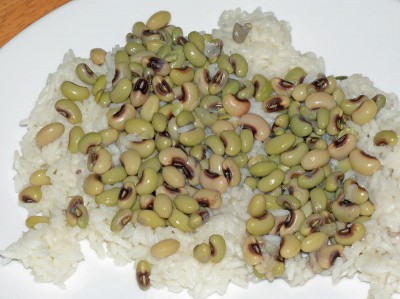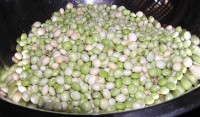If you’ve lived in eastern North Carolina for any length of time, you know there are two things you must eat on New Year’s Day: black-eyed peas for a lucky and prosperous year and a side of collard greens for added cash.

The peas represent all the coins destined for your pocket in the coming year. The collard greens stand for greenbacks. You could mix the two together for a beans and greens dish, but lots of folks, not just in North Carolina but all over the South, make hoppin’ john.
Supporter Spotlight
Hoppin’ john is a dish of black-eyed peas and rice seasoned with onions and bacon, although other pork cuts may be used, say ham hocks, salt pork or fatback. Everyone adds their own spices and seasonings.
Food historians believe hoppin’ john hails from the South’s Low Country region, which runs along the S.C. coast and up into North Carolina’s southernmost shore. Created by Africans, hoppin’ john is related to African pilaus, or rice simmered in a flavorful liquid, a preparation that has been recreated in countries around the world.

From the Low Country, hoppin’ john spread throughout the South. The name may have originated in Louisiana from the French Creole name for pigeon peas, which are similar to black-eyed peas, according to a N.C. State University study guide. The French Creole term for pigeon peas is “pois a pigeon,” which is pronounced “pwah peeJon,” not such a far stretch from how the words “hoppin’ john” sound.
The blend of peas and rice has been called hoppin’ john ever since the early 1800s. What appears to be the first published recipe for hoppin’ john showed up in the 1847 book The Carolina Housewife by Sarah Rutledge.
Supporter Spotlight
A good hoppin’ john should be flavorful, without too much meat in the mix. This is modest fare despite its promise of fortune. Never soupy, hoppin’ john’s peas and rice stand apart but are still moist. Start with dry black-eyed peas and the Carolina Gold rice that was grown in the Low Country and up into southeastern North Carolina starting in the late 1600s. Look for it at some supermarkets and specialty markets.
Recipes for hoppin’ john call for sparse seasonings. The peas and the pork do most of the work. That’s not to say you can’t play with the recipe. A little thyme, hot pepper, garlic and bell pepper all work in hoppin’ john. A splash of vinegar at the table is a fine condiment as is plenty of cracked black pepper and a crumbling of pork rinds or bacon.
And who’s to say you can’t go ahead and stir in those greens.
Hoppin’ John
3 pounds small dried black-eyed peas
8 cups water
2 pounds of ham hocks or bacon
2 medium onions, chopped
3 cups long-grain white rice
Salt and pepper to taste
1 teaspoon red pepper flakes (optional)
Wash and sort the peas. Place them in a saucepan, add the water, and discard any pebbles or peas that float.
Gently boil the peas with the ham hock and onion until tender but not mushy – about 1½ hours — or until 2 cups of liquid remain. Remove the meat from the ham hock bone and return the meat to the pot.
Add the rice to the pot, cover, and simmer on a very low setting, for about 30 minutes, never lifting the lid.
Remove from the heat and allow to sit, still covered, for another 10 minutes. Remove the cover, and season with salt and pepper to taste. Fluff the rice and peas with a fork and serve immediately. Makes 8 servings.
Source: N.C. State University.








